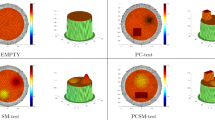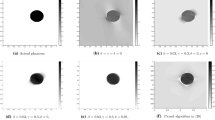A novel method for the numerical solution of a hybrid (coupled physics) inverse problem is proposed. Based on a regularized weighted mean curvature flow equation, this method can be considered as an alternative to the variational approach to solving weighted least gradient Dirichlet problems arising in electrical conductivity imaging, in particular, in Current Density Impedance Imaging (CDII). Utilizing the Sternberg–Ziemer theory, convergence of regularized solutions to a unique function of weighted least gradient is established. The numerical study is conducted to demonstrate the practicability and computational effectiveness of the proposed method.
Similar content being viewed by others
References
L. Alvarez, P. L. Lions, and J. M. Morel, “Image selective smoothing and edge detection by nonlinear diffusion II,” SIAM J. Numer. Anal., 29, 845–866 (1992).
G. Bal, “Hybrid inverse problems and internal measurements,” Inside Out II: MSRI Publications, 60, 325–364 (2012).
M. Benzi and M. Tuma, “A comparative study of sparse approximate inverse preconditioners,” Appl. Num. Math., 30, 305–340 (1999).
M. Benzi, “Preconditioning techniques for large linear systems: A survey,” J. Comp. Phys., 182, 418–477 (2002).
J. H. Bramble, B. E. Hubbard, and T. Vidar, “Convergence estimates for essentially positive type discrete Dirichlet problem,” Math. Comput., 23, No. 102, 695–709 (1969).
Y. G. Chen, Y. Giga, and S. Goto, “Uniqueness and existence of viscosity solutions of generalized mean curvature flow equations,” J. Diff. Geom., 33, 749–786 (1991).
M. G. Crandall, H. Ishi, and P. L. Lions, “Users guide to viscosity solutions of second order partial differential equations,” Bull. Amer. Math. Soc., 27, 1–67 (1992).
L. C. Evans and J. Spruck, “Motion of level sets by mean curvature. I,” J. Differ. Geom., 33, 635–681 (1991).
L. C. Evans and J. Spruck, “Motion of level sets by mean curvature. III,” J. Geom. Anal., 2, 121–150 (1992).
L. C. Evans and J. Spruck, “Motion of level sets by mean curvature. IV,” J. Geom. Anal., 5, 77–114 (1995).
D. Gilbarg and N. S. Trudinger, Elliptic Partial Differential Equations, 2nd ed., Springer-Verlag, New York, (2001).
R. Jerrard, A. Moradifam, and A. Nachman, “Existence and uniqueness of minimizers of general least gradient problems,” J. Reine und Angew. Math., 734, 71–97 (2018).
B. S. Jovanovipc and E. Sűli, Analysis of Finite Difference Scheme For Linear Partial Differential Equations With Generalized Solutions, Springer, London, (2014).
S. Handlovičova, K Mikula, and F. Sgallari, “Semi-implicit complimentary volume scheme for solving level set like equations in image processing and curve evolution,” Numer. Math., 23, 675–695 (2003).
J. Kačur and K. Mikula, “Solution of nonlinear diffusion appearing in image peocessing,” Appl. Numer. Math., 17, 47–59 (1995).
S. Kim, O. Kwon, J. K. Seo et al., “On a nonlinera partial differential equation arising in magnetic resonance electrical impedance tomography,” SIAM J. Math. Anal., 34, 511–526 (2002).
O. A. Ladyzhenskaya, V. A. Solonnikov, and N. N. Uraltseva, Linear and Qusilinear Equations of Parabolic Type, AMS, Providence, R.I., (1968).
O. A. Ladyzhenskaya, “Solution of the first boundary problem in the large for quasi-linear parabolic equations,” Trudy Moscov. Mat. Obšč., 7, 149–177 (1958).
A. Lichnewsky and R. Temam, “Pseudosolutions of the time-dependent minimal surface problem,” J. Differ. Eq., 30, 340–364 (1978).
A. Moradifam, A. Nachman, and A. Timonov, “A convergent algorithm for the hybrid problem of reconstructing conductivity from minimal interior data,” Inverse Problems, 28, 084003, (2012).
A. Moradifam, A. Nachman, and A. Tamasan, “Uniqueness of minimizers of weighted least gradient problems arising in hybrid inverse problems,” Calculus of Variations and PDEs, 57, (2018).
A. Nachman, A. Tamasan, and A. Timonov, “Conductivity imaging with a single measurements of boundary and interior data,” Inverse Problems, 23, 2556–2563 (2007).
A. Nachman, A. Tamasan, and A. Timonov, “Recovering the conductivity from a single measurement of interior data,” Inverse Problems, 25, 035014, (2009).
A. Nachman, A. Tamasan, and A. Timonov, “Current Density Impedance Imaging,” Contemp. Math., 25, 135–149 (2010).
A. Nachman, A. Tamasan, and A. Timonov, “Reconstruction of planar conductivities in subdomains from incomplete data,” SIAM J. Appl. Math., 70, 3342–3362 (2010).
A. Nachman, A. Tamasan, and J. Veras, “A weighted minimum gradient problem with complete electrode model boundary conditions for conductivity imaging,” SIAM J. Appl. Math., 76, 1321–1343 (2016).
A. M. Oberman, “A convergent monotone difference scheme for motion of level sets by mean curvature,” Numer. Math., 99, 365–379 (2004).
S. Osher and J. Sethian, “Fronts propagating with curvature-dependent speed: algorithms based on Hamilton-Jacobi formulations,” J. Comput. Phys., 79, 12–49 (1988).
E. Rothe, “Zweidimensionale parabolishe Randwertaufgaben als Grenzfall eidimensionaler Randwertaufgaben,” Math. Ann., 102, 650–670 (1930).
A. A. Samarskii, “On the convergence and accuracy of homogeneous difference schemes for one-dimensional and multidimensional parabolic equations,” USSR Comp. Math. Math. Phys., 2, No, 4, 654–696 (1963).
A. A. Samarskii and I. V. Fryazinov, “On finite-difference schemes for solving the Dirichlet problem for an elliptic equation with variable coefficients in an arbitrary region,” USSR Comp. Math. Math. Phys., 11, No. 2, 109–139 (1971).
A. A. Samarskii, The Theory of Difference Schemes, Marcell Decker Inc., New York, (2001).
J. Schauder, “Über lineare elliptische Differentialgleichungen zweiter Ordnung,” Math. Zeitschr., 38, No. 2, 257–283 (1934).
G. C. Scott, M. L. Joy, R. L. Armstrong, et. al., “Measirement of nonuniform current density by magnetic resonance,” IEEE Trans. Med. Imag., 10, 362–374 (1991).
J. Sethian, “Numerical algorithms for propagating interfaces: Hamilton-Jacobi equations and conservation laws,” J. Differ. Geom., 31, 131-161 (1990).
P. Sternberg and W. P. Ziemer, “Generalized motion by curvature with a Dirichlet condition,” J. Differ. Eq., 114, 80–600 (1994).
A. Tamasan, A. Timonov, and J. Veras, “Stable reconstruction of regular 1-harmonic maos with a given trace at the boundary,” Appl. Anal., 94, No. 6, 1098–1115 (2015).
A. Tamasan, and A. Timonov, “A regularized weighted least gradient problem for conductivity imaging,” Inverse Problems, 045006, (2019).
A. Timonov, “Numerical solution of a regularized weighted mean curvature flow problem for electrical conductivity imaging,” SIAM J. Sci. Comput., 41, No. 5, B1137–B1154 (2019).
T. D. Ventzel, “The first boundary problem and the Cauchy problem for quasi-linear parabolic equations with several space variables,” Mat. Sb. N. S., 41, No. 83, 499–520 (1957).
N. J. Walkington, “Algorithms for computing motion by mean curvature,” SIAM J. Numer. Anal., 33, 2215–2238 (1996).
Author information
Authors and Affiliations
Corresponding author
Additional information
Translated from Zapiski Nauchnykh Seminarov POMI, Vol. 499, 2021, pp. 105–128.
Rights and permissions
Springer Nature or its licensor (e.g. a society or other partner) holds exclusive rights to this article under a publishing agreement with the author(s) or other rightsholder(s); author self-archiving of the accepted manuscript version of this article is solely governed by the terms of such publishing agreement and applicable law.
About this article
Cite this article
Timonov, A. A Novel Method for the Numerical Solution of a Hybrid Inverse Problem of Electrical Conductivity Imaging. J Math Sci 273, 511–526 (2023). https://doi.org/10.1007/s10958-023-06517-8
Received:
Published:
Issue Date:
DOI: https://doi.org/10.1007/s10958-023-06517-8




